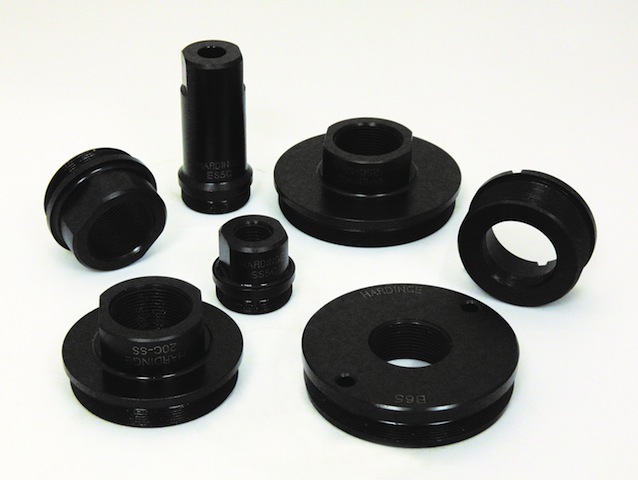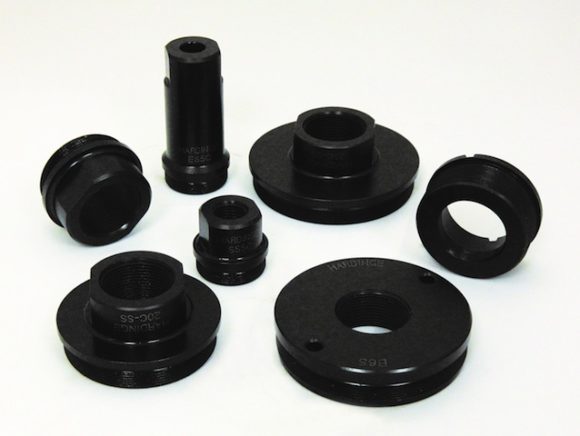The online version of Today’s Machining World continues to produce new feature stories such as this one from our best freelance writers.
You can increase production and reduce costs by exploiting what different jobs have in common.
The most obvious kind of part family is made up of items that share a name and geometry – 8-32 pan-head screws in different lengths, or a series of standoffs that come in different lengths, perhaps with different features (through hole or internal thread).
From a machining perspective, however, other characteristics can also define a family. Consider parts that you can
- hold in the same fixture
- run with variations on the same program
- make using the same type of operations
- cut with the same set of tools.
Sometimes it’s hard to see these commonalities, but once you do, you can use them to boost production by reducing setup and changeover time, minimize programming effort, or improve other aspects of your process.
Tooling
Parts made by the same processes and tooling might not look the same, said Rick Schonher, product manager for workholding, Hardinge, Inc., Elmira, N.Y., “but the operations performed will determine a family. You won’t be changing out tooling between parts.”
“The tooling is a family,” said Gerard Vacio, product manager for workholding, Big Kaiser Precision Tooling, Inc., Hoffman Estates, Ill. “A family of parts made with a particular grouping of production tools [will have] virtually no downtime between parts.”
You can expand this type of family by making the most of the limited space in the tool magazine – try to optimize the selection of tools to cut the greatest number of parts. Can you use one drill instead of three in different lengths?
Workholding
Usually people know when they a have family of parts, but don’t necessarily know how to make the most of it, said Wendy Swann, product manager, Chick Workholding Solutions, Warrendale, Pa. Workholding is generally the least-noticed aspect of machining part families, she said. However, the benefits of a family approach to workholding can be considerable. “If you are using the same set of jaws, the offsets are the same,” she said, saving time on every part you load.
For example you could use stepped jaws. The top, wider step could hold larger parts, the lower step or steps could hold smaller parts, Swann said. For milling round parts, you can use V-shaped jaws to hold a large range of diameters.
Your suppliers can help sort out how best to approach your workholding. “Typically [customers] share with us a sampling of part prints. We take those parts and separate them out into families using similar workholding,” said Schonher.
Programming
“If we’re lucky, the family of parts was identified as such by the designer; the drawing shows a generic part and has a table of the dimensions of the individual variations,” said Bill Gibbs, president, Gibbs and Associates, Moorpark, Cal., developers of GibbsCAM software. “The programmer can easily make use of this commonality in the program without doing anything especially sophisticated.”
As you add parts to a family, you may be able use portions of previously written programs. Suppose you are already making a part with a particular feature on it, and the customer asks you to make another part with the same feature – in a different size or location. You can copy the relevant section of the program and use it again, with appropriate adaptation.
More advanced software features help you to do more. If you repeatedly program a certain feature or process, you can write a macro, which will automatically run the desired series of commands. Plug-ins, often written by consultants, can take this approach to another level.
All in the family
“I love families of parts,” Gibbs said. “Setup and fixturing on a CNC machine is time consuming. A family can have one fixture to handle all parts.” Changing tools in the magazine takes time, but with a family of parts, “it will be possible not to retool the machine.”
Any opportunity to group, streamline, consolidate, rationalize, or optimize programming, tooling, workholding or other aspects of production can benefit your whole operation.
The fact you have a family of parts is not important. What you do with the family – how you use the family’s characteristics to help you increase production and reduce costs – that is the advantage you can gain from recognizing what parts have in common.
For more information:
Big Kaiser Precision Tooling, Inc.: www.bigkaiser.com
Chick Workholding Solutions: www.chickworkholding.com
Gibbs and Associates: www.Gibbscam.com
Hardinge Inc.: www.hardinge.com

Question: If you were forced to choose between Budweiser and Miller which one would you drink?


4 Comments
Miller by far.
I’d die of dehydration. Seriously, we are in a golden age of American brewing; there are many great brews available – they cost more, but you’ll drink less and enjoy it more. Find a good brewery in your area and support it.
Lloyd, As an 84 yr. old I was flattered to be asked to rep a successful local mfgr of carbide
end mills. He has a roomfull of Walters fluters, some w/ magazine loaders. A very successful
co. that makes medical device components cuts a dovetail on a 1/2″ dia sst 4″ blank and holds
it in mating soft collet 5c fixture and then machine the 3/16″ parts. When all the parts are done
they are held in jaws and he dovetail removed and the handfull on small partsare finished,
Harold A Voshage
I wholeheartedly agree with John Shea’s above comment. As a self proclaimed beer snob I would never in a million years even consider drinking the pedestrian aforementioned “beers”.
Support your local small breweries!